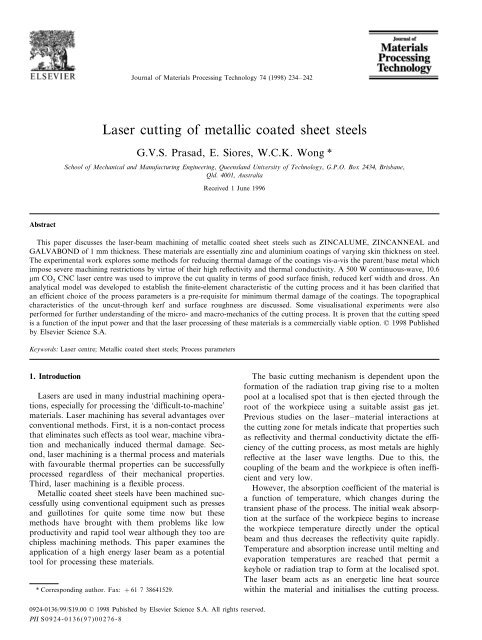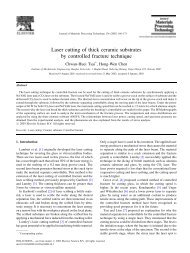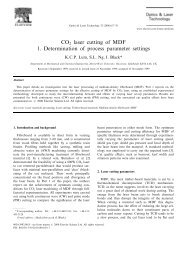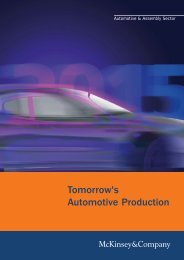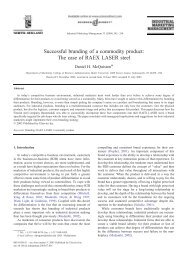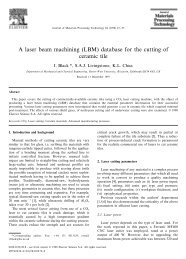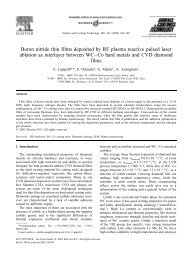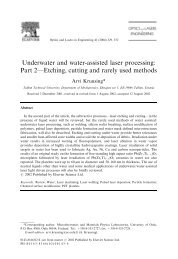Laser cutting of metallic coated sheet steels - World Lasers, Inc.
Laser cutting of metallic coated sheet steels - World Lasers, Inc.
Laser cutting of metallic coated sheet steels - World Lasers, Inc.
You also want an ePaper? Increase the reach of your titles
YUMPU automatically turns print PDFs into web optimized ePapers that Google loves.
Abstract<br />
Journal <strong>of</strong> Materials Processing Technology 74 (1998) 234–242<br />
<strong>Laser</strong> <strong>cutting</strong> <strong>of</strong> <strong>metallic</strong> <strong>coated</strong> <strong>sheet</strong> <strong>steels</strong><br />
G.V.S. Prasad, E. Siores, W.C.K. Wong *<br />
School <strong>of</strong> Mechanical and Manufacturing Engineering, Queensland Uni�ersity <strong>of</strong> Technology, G.P.O. Box 2434, Brisbane,<br />
Qld. 4001, Australia<br />
Received 1 June 1996<br />
This paper discusses the laser-beam machining <strong>of</strong> <strong>metallic</strong> <strong>coated</strong> <strong>sheet</strong> <strong>steels</strong> such as ZINCALUME, ZINCANNEAL and<br />
GALVABOND <strong>of</strong> 1 mm thickness. These materials are essentially zinc and aluminium coatings <strong>of</strong> varying skin thickness on steel.<br />
The experimental work explores some methods for reducing thermal damage <strong>of</strong> the coatings vis-a-vis the parent/base metal which<br />
impose severe machining restrictions by virtue <strong>of</strong> their high reflectivity and thermal conductivity. A 500 W continuous-wave, 10.6<br />
�m CO 2 CNC laser centre was used to improve the cut quality in terms <strong>of</strong> good surface finish, reduced kerf width and dross. An<br />
analytical model was developed to establish the finite-element characteristic <strong>of</strong> the <strong>cutting</strong> process and it has been clarified that<br />
an efficient choice <strong>of</strong> the process parameters is a pre-requisite for minimum thermal damage <strong>of</strong> the coatings. The topographical<br />
characteristics <strong>of</strong> the uncut-through kerf and surface roughness are discussed. Some visualisational experiments were also<br />
performed for further understanding <strong>of</strong> the micro- and macro-mechanics <strong>of</strong> the <strong>cutting</strong> process. It is proven that the <strong>cutting</strong> speed<br />
is a function <strong>of</strong> the input power and that the laser processing <strong>of</strong> these materials is a commercially viable option. © 1998 Published<br />
by Elsevier Science S.A.<br />
Keywords: <strong>Laser</strong> centre; Metallic <strong>coated</strong> <strong>sheet</strong> <strong>steels</strong>; Process parameters<br />
1. Introduction<br />
<strong>Laser</strong>s are used in many industrial machining operations,<br />
especially for processing the ‘difficult-to-machine’<br />
materials. <strong>Laser</strong> machining has several advantages over<br />
conventional methods. First, it is a non-contact process<br />
that eliminates such effects as tool wear, machine vibration<br />
and mechanically induced thermal damage. Second,<br />
laser machining is a thermal process and materials<br />
with favourable thermal properties can be successfully<br />
processed regardless <strong>of</strong> their mechanical properties.<br />
Third, laser machining is a flexible process.<br />
Metallic <strong>coated</strong> <strong>sheet</strong> <strong>steels</strong> have been machined successfully<br />
using conventional equipment such as presses<br />
and guillotines for quite some time now but these<br />
methods have brought with them problems like low<br />
productivity and rapid tool wear although they too are<br />
chipless machining methods. This paper examines the<br />
application <strong>of</strong> a high energy laser beam as a potential<br />
tool for processing these materials.<br />
* Corresponding author. Fax: +61 7 38641529.<br />
0924-0136/99/$19.00 © 1998 Pubished by Elsevier Science S.A. All rights reserved.<br />
PII S0924-0136(97)00276-8<br />
The basic <strong>cutting</strong> mechanism is dependent upon the<br />
formation <strong>of</strong> the radiation trap giving rise to a molten<br />
pool at a localised spot that is then ejected through the<br />
root <strong>of</strong> the workpiece using a suitable assist gas jet.<br />
Previous studies on the laser–material interactions at<br />
the <strong>cutting</strong> zone for metals indicate that properties such<br />
as reflectivity and thermal conductivity dictate the efficiency<br />
<strong>of</strong> the <strong>cutting</strong> process, as most metals are highly<br />
reflective at the laser wave lengths. Due to this, the<br />
coupling <strong>of</strong> the beam and the workpiece is <strong>of</strong>ten inefficient<br />
and very low.<br />
However, the absorption coefficient <strong>of</strong> the material is<br />
a function <strong>of</strong> temperature, which changes during the<br />
transient phase <strong>of</strong> the process. The initial weak absorption<br />
at the surface <strong>of</strong> the workpiece begins to increase<br />
the workpiece temperature directly under the optical<br />
beam and thus decreases the reflectivity quite rapidly.<br />
Temperature and absorption increase until melting and<br />
evaporation temperatures are reached that permit a<br />
keyhole or radiation trap to form at the localised spot.<br />
The laser beam acts as an energetic line heat source<br />
within the material and initialises the <strong>cutting</strong> process.
G.V.S. Prasad et al. / Journal <strong>of</strong> Materials Processing Technology 74 (1998) 234–242 235<br />
Thus, it is evident that for this keyhole-<strong>cutting</strong> process<br />
to be initiated, it is essential that the power density be<br />
high enough to overcome the reflection barrier. Once<br />
this is achieved, the process can be controlled using the<br />
melting and evaporation relationships.<br />
The goal in any laser machining process is to maximise<br />
the material removal rate whilst minimising the<br />
heat affected zone (HAZ). The objectives <strong>of</strong> this experimental<br />
study are: (i) to identify the parameters that<br />
have detrimental influence on the outcome <strong>of</strong> the <strong>cutting</strong><br />
process; (ii) to establish a relationship between<br />
traverse speed and input power; (iii) to examine the<br />
surface quality aspect through an analysis <strong>of</strong> the HAZ<br />
formed during the laser–material interaction by virtue<br />
<strong>of</strong> the oxidation <strong>of</strong> the coatings directly under the<br />
optical beam; and (iv) to analyse the trade-<strong>of</strong>f between<br />
the material removal rate and the HAZ.<br />
2. <strong>Laser</strong>–metal interactions<br />
Although the CO 2 laser <strong>cutting</strong> <strong>of</strong> metals has become<br />
a well established manufacturing process, the processing<br />
<strong>of</strong> <strong>metallic</strong> <strong>coated</strong> <strong>sheet</strong> <strong>steels</strong> is considered as<br />
‘difficult’. These materials are cut at lower speeds and<br />
at thinner maximum sections than for most other<br />
metals. The reasons behind this reduction in the <strong>cutting</strong><br />
efficiency as compared with, for example <strong>steels</strong>, can be<br />
accounted for by examining the physical properties <strong>of</strong><br />
these materials: (i) their reflectivity to the 10.6 �m CO 2<br />
laser radiation is very high, up to 99% at room temperature;<br />
and (ii) their thermal conductivity is approximately<br />
thrice that <strong>of</strong> other metals such as mild <strong>steels</strong>.<br />
The principles <strong>of</strong> laser processing <strong>of</strong> metals suggest<br />
that the <strong>cutting</strong> process depends upon the establishment<br />
<strong>of</strong> a localised area <strong>of</strong> melting and/or evaporation<br />
throughout the depth <strong>of</strong> the workpiece. The melt thus<br />
generated by the focused beam is removed from the cut<br />
zone by the incident gas jet, which is also chemically<br />
reactive with the melt. The chemical reaction most<br />
<strong>of</strong>ten employed is the exothermic oxidation <strong>of</strong> the<br />
<strong>metallic</strong> surface under the heat <strong>of</strong> the laser radiation.<br />
The melt is chemically degraded and the reaction forms<br />
a secondary heat input to the cut zone.<br />
The high reflectivity and thermal conductivity makes<br />
it very difficult to establish a localised molten zone. At<br />
ambient temperatures, all metals have high reflectivity<br />
(�99%) to the incident laser beam. The small proportion<br />
<strong>of</strong> the absorbed light has the effect <strong>of</strong> heating the<br />
area under the beam and the subsequent rise in temperature<br />
is accompanied by a reduction in reflectivity. This<br />
reduction in reflectivity results in further heating until a<br />
highly absorptive molten pool is established.<br />
The small percentage <strong>of</strong> heat that is absorbed by the<br />
material is converted into heat but is quickly dissipated<br />
across the surface <strong>of</strong> the <strong>sheet</strong> by virtue <strong>of</strong> its high<br />
thermal conductivity. As a result <strong>of</strong> the low thermal<br />
input and the rapid dissipation <strong>of</strong> the heat, a highly<br />
absorptive, localised hot spot is established less readily<br />
that in the case <strong>of</strong> other metals. Continuing the comparison<br />
with <strong>steels</strong>, the aluminium exothermic reaction:<br />
(4)Al+(3)O2=(2)AL2O3+1670 kJ/mol (1)<br />
1is far less effective as a heat source in the cut zone than<br />
the similar reaction employed when <strong>cutting</strong> <strong>steels</strong>:<br />
(4)Fe+(3)O2=(2)Fe2O3+822 kJ/mol (2)<br />
The aluminium oxidation reaction is capable <strong>of</strong> generating<br />
more energy than the iron reaction but the<br />
oxide generated forms an impermeable seal on the<br />
surface <strong>of</strong> the underlying aluminium and thereby suppresses<br />
any further reaction with oxygen. During laser<br />
<strong>cutting</strong>, this seal is continuously fractured due to the<br />
turbulent nature <strong>of</strong> the melt flow out <strong>of</strong> the cut zone.<br />
Consequent to this turbulence, the oxidation reaction<br />
can act as a substantial thermal input to the <strong>cutting</strong><br />
process although its contribution is not <strong>of</strong> the same<br />
order <strong>of</strong> magnitude as that <strong>of</strong> the oxidation <strong>of</strong> iron<br />
during the <strong>cutting</strong> <strong>of</strong> <strong>steels</strong>.<br />
The foregoing theoretical aspects were considered in<br />
the experimental investigations conducted on the specimens.<br />
The work was carried out using a Cincinnati<br />
CL-5 CNC <strong>Laser</strong> Centre with the combination <strong>of</strong> high<br />
power modulation and good mode, attaining extremely<br />
high energy densities, so that the problems <strong>of</strong> high<br />
reflectivity and thermal conductivity could be overcome.<br />
3. Experimental methodology<br />
These series <strong>of</strong> experiments were carried out using<br />
the Cincinnati CL-5 CNC <strong>Laser</strong> Centre at different<br />
power inputs with a view to optimise the cut quality.<br />
The machine produces a beam with a wave length in<br />
the range <strong>of</strong> 3×10 −7 –3×10 −3 �m. The beam was<br />
focused using a 127 mm focal length lens and a simple<br />
conical <strong>cutting</strong> nozzle that had a exit diameter <strong>of</strong> 1.7<br />
mm with the nozzle–workpiece stand<strong>of</strong>f distance being<br />
1 mm.<br />
The <strong>cutting</strong> head assembly <strong>of</strong> the machine is designed<br />
such that turning the materials follower changes the<br />
distance from the lens to the workpiece. Adjusting the<br />
material follower thus moves the beam focal point<br />
above or below the material surface. The material<br />
follower rotates (relative to the lens assembly) on<br />
threads that move it vertically 0.05 in. (1.27 mm) per<br />
revolution, over a total range <strong>of</strong> 0.4 in. or eight full<br />
turns.<br />
1 Enthalpies <strong>of</strong> formation at 293 K (for comparison only).
236<br />
G.V.S. Prasad et al. / Journal <strong>of</strong> Materials Processing Technology 74 (1998) 234–242<br />
Oxygen was employed as the assist gas which is also<br />
the primary assist gas specified for the machine, whilst<br />
up to eight different gases can be incorporated into the<br />
experimental design. The flow rates and the operating<br />
pressures <strong>of</strong> the assist gas generally depend on each<br />
specific application. Three process parameters were<br />
identified as important in the <strong>cutting</strong> <strong>of</strong> the specimens<br />
under study viz., input power, <strong>cutting</strong> velocity and the<br />
assist gas pressure.<br />
3.1. Input power<br />
The drastic fluctuation in the melting and evaporation<br />
temperatures <strong>of</strong> the coatings and the parent/base<br />
metal renders the input power one <strong>of</strong> the crucial factors<br />
in achieving optimum machining quality. The initial set<br />
<strong>of</strong> experiments conducted for varying power input in<br />
the range 450–700 W produced deteriorating quality <strong>of</strong><br />
cuts in all <strong>of</strong> the specimens. It was decided to modulate<br />
the power at 500 W and vary the <strong>cutting</strong> velocity and<br />
the assist gas pressure.<br />
3.2. Cutting �elocity<br />
Most laser systems are based on a low pressure<br />
<strong>cutting</strong> head that means that the maximum <strong>cutting</strong><br />
pressure is limited by the optical system in the <strong>cutting</strong><br />
head. Lenses normally made <strong>of</strong> GaAs or ZnSe are<br />
specified to withstand a maximum pressure <strong>of</strong> about 5<br />
bar. It is generally known that the <strong>cutting</strong> velocity<br />
increases with increasing gas pressure. There is a particular<br />
area in which high quality cuts appear. The maximum<br />
velocity is found at pressures <strong>of</strong> around 5 bar.<br />
Investigations indicate that there is a gap between the<br />
theoretically calculated and the experimentally obtainable<br />
<strong>cutting</strong> velocities, which indicate more scope for<br />
improvements.<br />
3.3. Assist gas pressure<br />
The oxygen pressure was increased in the range 5–20<br />
bar. At levels <strong>of</strong> 20 bar, the material begins to act like<br />
a mirror and there is no interaction between the material<br />
and the incident beam. This implies that for a<br />
specific laser power, there is a particular pressure range<br />
within which the material can be processed. The gas<br />
pressure variation was thus limited to a maximum <strong>of</strong> 14<br />
bar. The <strong>cutting</strong> rate as a function <strong>of</strong> input power was<br />
investigated.<br />
The cuts were evaluated in terms <strong>of</strong> fine, good,<br />
acceptable and poor quality. The qualities were optimised<br />
by optimising the focal point position <strong>of</strong> the<br />
focusing optics <strong>of</strong> the laser system.<br />
4. Results and discussion<br />
The basic philosophy behind the discussion is that<br />
the wasted energy, which does not contribute to the<br />
<strong>cutting</strong> process, should not be viewed as an aspect <strong>of</strong><br />
the laser–material interaction. Ignoring the reflected<br />
energy which is not, by definition, an input to the<br />
<strong>cutting</strong> process, the losses by conduction, convection<br />
and radiation can be treated solely as a function <strong>of</strong> the<br />
melt on its surroundings.<br />
A simple analytical model <strong>of</strong> the above can be interpreted<br />
with the help <strong>of</strong> the following energy balance<br />
equation:<br />
Input energy=(energy used in <strong>cutting</strong>)+<br />
(losses by conduction, convection and radiation)<br />
As an initial approximation, assume that the specific<br />
<strong>cutting</strong> energy used to remove a unit volume <strong>of</strong> cut<br />
material is independent <strong>of</strong> the material thickness. The<br />
energy used in <strong>cutting</strong> is, therefore, a function <strong>of</strong> this<br />
specific <strong>cutting</strong> energy multiplied by the volume <strong>of</strong> the<br />
material removed during the <strong>cutting</strong>. The losses by<br />
conduction, convection and radiation are a function <strong>of</strong><br />
the temperature <strong>of</strong> the <strong>cutting</strong> front and its surface area<br />
in contact with its surroundings. Under these conditions,<br />
the energy balance equation can be written as<br />
follows.If a laser power P can cut a line L in time t,<br />
then:<br />
(P−b)t(x/100)=E cutldk+tBdk/2(A+B+C) (3)<br />
where b is the laser power transmitted to the cut zone;<br />
x is the absorptivity <strong>of</strong> the cut zone; E cut is the specific<br />
energy needed to melt and remove a unit volume <strong>of</strong><br />
material from the cut zone; d is the material thickness<br />
and A, B and C are the conductive, radiative and<br />
convective loss functions.<br />
Theory suggests that during <strong>cutting</strong>, it is <strong>of</strong>ten the<br />
case that the trailing edge <strong>of</strong> the cut front does not<br />
extend to the full diameter <strong>of</strong> the incident beam. A<br />
proportion <strong>of</strong> the light therefore passes straight through<br />
the kerf without interacting with the cut front. Consequently,<br />
the absorptivity will partially be much higher<br />
than the theoretical values at ambient room temperature.<br />
This is because the cut zone has its absorptivity<br />
increased as a result <strong>of</strong> the high temperature, the presence<br />
<strong>of</strong> oxides, the shallow angle <strong>of</strong> incidence <strong>of</strong> the<br />
laser beam, the roughness and the absorptive layer <strong>of</strong><br />
vapour.<br />
The specific <strong>cutting</strong> energy can be assumed constant<br />
for any given material as all cuts appear similar and<br />
thus can be thought <strong>of</strong> as being produced by similar<br />
mechanisms. Based on this assumption, the average<br />
<strong>cutting</strong> temperature can also be assumed to remain<br />
constant for a given material. Considering the losses
G.V.S. Prasad et al. / Journal <strong>of</strong> Materials Processing Technology 74 (1998) 234–242 237<br />
indicated in the above equation, the conductive losses<br />
per unit area <strong>of</strong> <strong>cutting</strong> front can again be assumed to<br />
be constant for a given material, so that while the<br />
conductive heat loss is generally determined by the<br />
temperature <strong>of</strong> the heat sink and the heat source, this<br />
factor will not interfere with the central idea <strong>of</strong> this<br />
discussion.<br />
The foregoing will also conveniently imply that the<br />
convective and radiative heat losses per unit area can be<br />
approximated to be proportional to the surface area <strong>of</strong><br />
the front. It follows that in the equation, the energy<br />
used in <strong>cutting</strong> is independent <strong>of</strong> the <strong>cutting</strong> time. The<br />
losses will then be proportional to the <strong>cutting</strong> time, so<br />
Fig. 1. Graphs <strong>of</strong> input power (W) vs. <strong>cutting</strong> rate (mm min 1 ): (a)<br />
GALVABOND; (b) ZINCANNEAL; (c) ZINCALUME.<br />
that the proportion <strong>of</strong> the useful and the wasted energy<br />
will change if the <strong>cutting</strong> speed is changed in order to<br />
cut materials <strong>of</strong> different thickness.<br />
4.1. Effect <strong>of</strong> material thickness on <strong>cutting</strong> speeds<br />
In the equation, suppose that d is halved at the same<br />
laser power input:<br />
(P−b)(t/2)(x/100)=E cutlk(d/2)+tBdk/4(A+B+C)<br />
(4)<br />
For the sake <strong>of</strong> comparison, let everything be doubled<br />
in Eq. (4):<br />
(P−b)t(x/100)=E cutldk+(t/2)Bdk(A+B+C) (5)<br />
It is clear that the imbalance in the equation with<br />
respect to Eq. (3) is that the losses have been halved.<br />
Thus, the equation can be balanced by simply manipulating<br />
t.<br />
The foregoing clearly implies that there is a specific<br />
limit to the material thickness beyond which the <strong>cutting</strong><br />
mechanism breaks down and cannot be re-established<br />
at any <strong>cutting</strong> speed. The reason for this is the relative<br />
increase in thermal losses from the cut zone as the<br />
<strong>cutting</strong> speed is decreased. In the case <strong>of</strong> the machining<br />
<strong>of</strong> the materials under study, the thermal conductivity<br />
<strong>of</strong> the coatings dictates the <strong>cutting</strong> speed although the<br />
material thickness is not the primary concern.<br />
The effects <strong>of</strong> the rapid oxidation reactions have to<br />
be considered in determining the optimum selection <strong>of</strong><br />
the input power and the proportional increase in the<br />
<strong>cutting</strong> speeds. In this case, it follows that with an<br />
increase in the material thickness, there is a proportional<br />
increase in the energy wasted, but this is more<br />
gradual, due mainly to the dissipation <strong>of</strong> the energy<br />
across the material surface by virtue <strong>of</strong> high thermal<br />
conductivity. In other words, there is less concentration<br />
<strong>of</strong> energy absorbed in any particular region across the<br />
material surface.<br />
4.2. Impact <strong>of</strong> the incident beam on the surface <strong>of</strong> the<br />
material<br />
Fig. 1 shows graphs plotted for input power versus<br />
<strong>cutting</strong> rates. It can be inferred that GALVABOND<br />
specimens are cut faster than the ZINCALUME and<br />
ZINCANNEAL specimens. This is due to the aluminium<br />
coating being highly absorptive at the laser<br />
wavelength <strong>of</strong> 10.6 �m. The oxides thus formed are<br />
firmly bonded to the substrate and are not vaporised by<br />
the incident beam, owing to their high melting and<br />
boiling points. This highly absorptive and refractory<br />
surface replaces the original aluminium surface and so<br />
the problems associated with reflection are minimised.
238<br />
G.V.S. Prasad et al. / Journal <strong>of</strong> Materials Processing Technology 74 (1998) 234–242<br />
Fig. 2. Comparison <strong>of</strong> kerf widths: (a) GALVABOND; (b) ZINCALUME; (c) ZINCANNEAL.<br />
4.3. Influence <strong>of</strong> the assist gas on <strong>cutting</strong><br />
The photographs in Fig. 4 show the effect <strong>of</strong> the<br />
<strong>cutting</strong> gas on the surface <strong>of</strong> the various specimens.<br />
There is greater/pronounced surface disintegration in<br />
the case <strong>of</strong> GALVABOND specimens as compared<br />
with the others. This is indicated by the distinct oxide<br />
formation along the length <strong>of</strong> the cut. The cut edge<br />
surfaces represent the extreme edge <strong>of</strong> the molten cut<br />
zone which is then left behind by the <strong>cutting</strong> process. In<br />
this region, the melt is in contact with the parent/base<br />
metal, where the temperature is not greatly in excess <strong>of</strong><br />
the melting point <strong>of</strong> the base metal.<br />
This low temperature melt has a higher surface tension<br />
than the much hotter top surface <strong>of</strong> the coating at<br />
the centre <strong>of</strong> the laser–material interaction zone. This<br />
surface tension gradient acts to draw the molten material<br />
towards the sides <strong>of</strong> the cut whilst it is at the same<br />
time being propelled vertically downwards by the impinging<br />
gas jet. In this way, the molten materials can<br />
accumulate on the bottom <strong>of</strong> the cut edge and will<br />
thereafter solidify as dross. Further, the melt zone is<br />
covered with the oxide coating, which tends to increase<br />
the overall melt surface tension. Also, experience from<br />
brazing has shown that a hotter surface tends to attract<br />
the melt more efficiently hence the hotter, the lower the<br />
surface tension.<br />
High surface tension forces tend to restrict the surface<br />
geometry <strong>of</strong> fluid to large radii. This reduction in<br />
the melt surface tension might have been expected to<br />
accelerate the <strong>cutting</strong> process. The gas moving through<br />
the cut zone acts primarily as a mechanical propellant<br />
<strong>of</strong> the liquid metal out <strong>of</strong> the cut zone. Chemically, it<br />
can possibly also act as a source <strong>of</strong> energy if oxygen is<br />
input to the <strong>cutting</strong> process but it must be borne in<br />
mind that the gas also serves to refrigerate the <strong>cutting</strong><br />
zone by forced convective cooling. Using this interpretation,<br />
it can be predicted that the higher specific heat<br />
and thermal conductivity <strong>of</strong> some other assist gas such<br />
as nitrogen or helium should render it more effective as<br />
a means <strong>of</strong> cooling the laser melt zone.<br />
4.4. Kerf width analysis<br />
The kerf width <strong>of</strong> all the cuts carried out for this<br />
experimental programme varied only slightly about an
G.V.S. Prasad et al. / Journal <strong>of</strong> Materials Processing Technology 74 (1998) 234–242 239<br />
Fig. 3. Microphotographs <strong>of</strong> the transverse edge: (a) GALVABOND; (b) ZINCANNEAL; (c) ZINCALUME.<br />
average value <strong>of</strong> 250 �m with the ZINCANNEAL and<br />
ZINCALUME specimens occupying the range 220–250<br />
�m and the GALVABOND specimens in the 250–270<br />
�m range (see Fig. 2). This is in close conformity with<br />
the studies undertaken by other researchers for similar<br />
metals and most <strong>of</strong> the results reported thus far exhibit<br />
this tendency towards uniformity <strong>of</strong> the kerf width.<br />
This almost independence <strong>of</strong> the kerf width with respect<br />
to <strong>cutting</strong> speed, material thickness or the type <strong>of</strong> assist<br />
gas used, is reminiscent <strong>of</strong> mechanical <strong>cutting</strong> methods<br />
and it can be postulated that for a particular combination<br />
<strong>of</strong> laser–lens–metal, the focused laser assumed an<br />
effective width which is not necessarily changed by<br />
altering the process parameters. The metal itself determines<br />
this width as a result <strong>of</strong> its high thermal conductivity,<br />
which effectively cools all the material not<br />
directly irradiated by the beam and thereby prevents<br />
lateral expansion <strong>of</strong> the kerf width.<br />
4.5. Influence <strong>of</strong> assist gas pressure on the <strong>cutting</strong><br />
At pressure <strong>of</strong> around 5 bar, good quality cuts were<br />
obtained for ZINCALUME nad ZINCANNEAL, (see<br />
Fig. 3) with insignificant burr and heat-affected zone<br />
(HAZ) while GALVABOND exhibited a little wider<br />
HAZ. The <strong>cutting</strong> velocity increased with increasing gas<br />
pressure by about 60% as the gas pressure moved from<br />
5 to 20 bar. Repeat experiments for GALVABOND<br />
revealed that the parameter area in which good quality<br />
cuts are obtained narrowed compared to low gas pressure<br />
parameters. At low <strong>cutting</strong> velocities, the high O 2<br />
pressure resulted in a strong burring effect that was<br />
uncontrollable and produced a wide irregular kerf.<br />
It can be inferred that this is due to the high pressure<br />
<strong>of</strong> pure oxygen that reacts with zinc and steel, forming<br />
zinc and chromium oxides along the edges <strong>of</strong> the cuts.<br />
End results indicated that at higher O 2 pressures, the<br />
<strong>cutting</strong> velocities increased in the range <strong>of</strong> 40–70%,<br />
proving machining pr<strong>of</strong>itable for these specimens using<br />
the high energy laser.<br />
4.6. Metallographic in�estigation<br />
The micrographs in Fig. 5 show the front views <strong>of</strong><br />
the specimens. While the HAZ is very narrow in ZIN-<br />
CALUME and ZINCANNEAL specimens, it is more<br />
pronounced in the case <strong>of</strong> GALVABOND. This is also<br />
true for the case <strong>of</strong> oxide deposition across the length
240<br />
G.V.S. Prasad et al. / Journal <strong>of</strong> Materials Processing Technology 74 (1998) 234–242<br />
<strong>of</strong> cut. The figure covers the area towards the bottom <strong>of</strong><br />
the cut edge, and clearly shows the adhesive dross and<br />
the porous nature <strong>of</strong> the resolidified molten zone. The<br />
angularity <strong>of</strong> most <strong>of</strong> the pores implies that they are the<br />
result <strong>of</strong> the entrapment <strong>of</strong> the gas from the top to the<br />
bottom <strong>of</strong> the cut. Also, a kind <strong>of</strong> folding mechanism is<br />
revealed in the lines parallel to the cut edge. During the<br />
fluid flow from the central hot spot to the side <strong>of</strong> the<br />
cut zone, it could be possible that the two adjacent,<br />
oxidised surfaces can come into contact and become<br />
trapped as a linear inclusion <strong>of</strong> the type shown in the<br />
figure.<br />
Fig. 4. Microphotographs <strong>of</strong> the top surface: (a) ZINCALUME; (b)<br />
ZINCANNEAL; (c) GALVABOND.<br />
4.7. Control <strong>of</strong> dross<br />
While the deposition <strong>of</strong> dross on the lower edge <strong>of</strong><br />
the cut is an undesirable effect, it is rather easy to<br />
remove mechanically in the case <strong>of</strong> these specimens by<br />
either scraping or abrasion. To minimise the dross,<br />
there are numerous techniques available. One option<br />
could be the use <strong>of</strong> a pulsed laser beam rather than a<br />
CW mode. This is because the peak energy <strong>of</strong> a pulsed<br />
laser beam is much higher than the CW output but the<br />
average output is generally lower.<br />
The high peak powers <strong>of</strong> each pulse should act to<br />
rapidly melt and vaporise these <strong>metallic</strong> coatings. A cut<br />
can be carried out in this way with minimum surplus<br />
melting by conduction effects. This reduction in the<br />
surplus melting could further inhibit the generation <strong>of</strong><br />
dross although the <strong>cutting</strong> speeds tend to be lower than<br />
for the higher power CW mode.<br />
5. Conclusions<br />
The <strong>metallic</strong> <strong>coated</strong> <strong>sheet</strong> <strong>steels</strong> under study, i.e.<br />
ZINCALUME, ZINCANNEAL and GALVABOND,<br />
can be cut at commercially acceptable rates in the<br />
observed thickness range <strong>of</strong> 0.5–1.0 mm at high laser<br />
powers. While the <strong>cutting</strong> speed is same in the case <strong>of</strong><br />
ZINCALUME and ZINCANNEAL, it is slightly<br />
higher (about 20%) in the case <strong>of</strong> GALVABOND. The<br />
input power, <strong>cutting</strong> velocity and the assist gas pressure<br />
dictate the quality <strong>of</strong> cuts obtainable in the machining<br />
<strong>of</strong> these materials.<br />
Oxygen is quite effective as an assist gas for the<br />
<strong>cutting</strong> process as far as the <strong>cutting</strong> speeds are concerned.<br />
However, difficulties associated with localised<br />
overheating, particularly in the case <strong>of</strong> GALVABOND<br />
specimens, may be encountered if detailed work is<br />
required. In the laser <strong>cutting</strong> <strong>of</strong> GALVABOND specimens,<br />
the oxidised edges can be totally eliminated by<br />
using some other assist gas such as nitrogen or helium,<br />
which should render totally oxidised-free cut edges.<br />
If two different laser powers are compared, it is<br />
probable that the higher power will have an inferior<br />
mode quality which will not focus to as small spot as<br />
the lower power. This larger focal spot will produce a<br />
wider cut, thus rendering the process less efficient, as<br />
more material will have to be removed to generate the<br />
cut.<br />
The fluid dynamics <strong>of</strong> the cut zone play a very<br />
important role in determining the material removal<br />
rate. <strong>Inc</strong>rease in power input changes the inclination<br />
and the geometry <strong>of</strong> the cut front, which will in turn,<br />
induce changes in the material removal rates. Thus,<br />
above a limiting <strong>cutting</strong> speed, the viscosity <strong>of</strong> the melt<br />
may become the rate determining factor.
G.V.S. Prasad et al. / Journal <strong>of</strong> Materials Processing Technology 74 (1998) 234–242 241<br />
Fig. 5. Microphotographs <strong>of</strong> the front view: (a) GALVABOND; (b) ZINCALUME; (c) ZINCANNEAL.<br />
As a result <strong>of</strong> the reduction in thermal losses to the<br />
workpiece when <strong>cutting</strong> at higher speeds, the thermal<br />
gradients around the <strong>cutting</strong> zone become more severe<br />
as the material along the cut line is not preheated by<br />
the moving cut front and therefore requires more energy<br />
to become melted and ejected.<br />
Slag-free cuts are obtainable in the <strong>cutting</strong> <strong>of</strong> ZIN-<br />
CALUME and ZINCANNEAL but in the case <strong>of</strong><br />
GALVABOND, the oxides formed are concentrated in<br />
the slag. Owing to the high thermal conductivity and<br />
melting point, the slag solidifies before it leaves the<br />
kerf.<br />
It is observed that the slag is partly pressed into the<br />
melt zone in the cut kerf, which could cause problems<br />
when these specimens are subjected to further processing.<br />
Adherent dross is generally formed at the lower edge<br />
<strong>of</strong> the cut as a result <strong>of</strong> high surface tension forces and<br />
surface tension gradients within the melt. While dross<br />
can be easily removed, it can also be minimised by<br />
pulsed laser <strong>cutting</strong>, which is <strong>of</strong> course, at the expense<br />
<strong>of</strong> the <strong>cutting</strong> speed or probably by the use <strong>of</strong> a dross<br />
jet which directs all the dross onto the waste-material<br />
side <strong>of</strong> the cut.<br />
5.1. Implication <strong>of</strong> the arguments<br />
It is evident from the foregoing results and discussion<br />
that the analytical model thus developed exhibits a<br />
finite-element character, when applied to the materials<br />
under consideration. This is due to the presence <strong>of</strong><br />
different materials <strong>of</strong> various thicknesses and their<br />
sandwiching influence. The simplified model precludes<br />
the possibility <strong>of</strong> studying the laser–material interactions<br />
at the various interfaces, where the real time<br />
interactions continue to remain drastic and intricate, by<br />
virtue <strong>of</strong> different expansion rates <strong>of</strong> the metals, viz.<br />
zinc, aluminium and steel, as the beam power travels<br />
down the sandwich, thereby giving rise to different<br />
temperature gradients at the interfaces.<br />
Although it is intended to amplify the model to<br />
investigate the laser <strong>cutting</strong> <strong>of</strong> <strong>metallic</strong> <strong>coated</strong> <strong>sheet</strong>
242<br />
G.V.S. Prasad et al. / Journal <strong>of</strong> Materials Processing Technology 74 (1998) 234–242<br />
<strong>steels</strong> in future work, the situation is rather complex,<br />
considering the composition <strong>of</strong> these specimens. The<br />
model developed so far thus provide scope for further<br />
modifications in the light <strong>of</strong> the above-mentioned intricacies<br />
and can be modified to accommodate the interactions<br />
at the interfaces <strong>of</strong> the sandwich <strong>of</strong> the specimens<br />
in terms <strong>of</strong> the temperature gradients and the different<br />
coefficients <strong>of</strong> linear expansions <strong>of</strong> the various metals.<br />
Acknowledgements<br />
The authors wish to express their thanks and<br />
appreciation to BHP Steels Ltd., Australia, for<br />
providing the specimens and the Queensland<br />
Manufacturing Institute, Brisbane, Australia, for the<br />
Cincinatti CL-5 CNC laser centre to carry out the<br />
experiments.<br />
Bibliography<br />
[1] Y. Arata, I. Miyamoto, Metal heating by laser beam, Weld.<br />
Constr. 57 (8) (1978) 239.<br />
[2] Y. Arata, I. Miyamoto, Some fundamental properties <strong>of</strong> highpower<br />
laser beam as a heat source (report 2)—CO 2 laser absorption<br />
characteristics <strong>of</strong> metals, Trans. Jpn. Weld. Soc. 3 (1) (1972)<br />
152–162.<br />
[3] F.N. Birkett et al., Prevention <strong>of</strong> dross attachment during laser<br />
<strong>cutting</strong>, in: F. Kimmit (Ed.), Proc. 2nd Int. Conf. on <strong>Laser</strong>s in<br />
Manufacturing, 26–28 March 1985, Birmingham, UK, IFS,<br />
Bedford, UK, 1985, pp. 63–66.<br />
[4] G. Buness, S. Weber, New <strong>sheet</strong> metal <strong>cutting</strong> using CO 2 lasers,<br />
ZIS Mitt. 19 (1) (1977) 120–129.<br />
[5] J.S. Ekersley, <strong>Laser</strong> <strong>cutting</strong> <strong>of</strong> <strong>sheet</strong> steel with the revolutionary<br />
turbolase T1000 CO 2 laser, in: ICAEO 1982, Proc. Mater.<br />
Process. Symp. 31 (1982) pp. 20–23, September, 1982, Boston,<br />
MA, <strong>Laser</strong> Institute <strong>of</strong> America, Toledo, OH, pp. 131–134.<br />
[6] S.G. Gornyi et al, et al., An investigation <strong>of</strong> the process <strong>of</strong><br />
gas-laser metal <strong>cutting</strong>, Weld. Eng. 3 (1992) 31–32.<br />
[7] V.G. Gregson, <strong>Laser</strong> metal <strong>cutting</strong>, Mach. Tool Blue Book 76<br />
(9) (1981) 72–75.<br />
.<br />
.<br />
[8] A.G. Grigoryants, Basics <strong>of</strong> <strong>Laser</strong> Material Processing, Mir<br />
Publishers, Moscow, 1994.<br />
[9] S. Hoshinouchi, M. Kobayashi, et al., Quality improvement in<br />
CO 2 laser <strong>cutting</strong> <strong>of</strong> metals, in: Colloq. on Thermal Cutting and<br />
Flame Processes, 7 September, 1982, Ljubljana, Yugoslavia,<br />
International Institute for Welding, London, UK, 1982.<br />
[10] J.N. Kamulu, W.M. Steen, The importance <strong>of</strong> gas flow parameters<br />
in laser <strong>cutting</strong>, in: Metall. Soc. AMIE, Paper No. 81-38,<br />
Warrendale, PA.<br />
[11] E.P. Kudrayavstev, A.V. Tikhomirov, Gas laser <strong>cutting</strong> <strong>of</strong> materials,<br />
in: Colloq. on Thermal Cutting and Flame Processes, 7<br />
September, 1982, Ljubljana, Yugoslavia, International Institute<br />
for Welding, London, UK, 1982.<br />
[12] C.S. Lee, A. Goel, H. Osada, Parametric studies <strong>of</strong> pulsed laser<br />
<strong>cutting</strong> <strong>of</strong> thin metal plates, in: J. Majumdar (Ed.), ICALEO<br />
1984, Proc. Mater. Process. Symp. 44, 12–15 November 1984,<br />
MA, <strong>Laser</strong> Institute <strong>of</strong> America, Toledo, OH, 1985, pp. 86–93.<br />
[13] M. Lepore, et al., A quantative theory for the role <strong>of</strong> oxygen in<br />
the laser <strong>cutting</strong> process (Centro <strong>Laser</strong>, Italy), in: E.A. Metzbower<br />
(Ed.), ICALEO ’83, Proc. Mater. Process. Symp. 38,<br />
November 1983) Los Angeles, CA, <strong>Laser</strong> Institute <strong>of</strong> America,<br />
Toledo, OH, 1984, pp. 160–165.<br />
[14] G. Manassero, et al., <strong>Laser</strong> beam <strong>cutting</strong> <strong>of</strong> <strong>metallic</strong> and structural<br />
components, Commission <strong>of</strong> the European Communities,<br />
Luxembourg, 1985, p. 27.<br />
[15] J. Mazumdar, W.M. Steen, Heat transfer model for CW laser<br />
material processing, J. Appl. Phys. 51 (2) (1980) 941–947.<br />
[16] M. Mitani, et al., <strong>Laser</strong> <strong>cutting</strong> <strong>of</strong> aluminium thin film with no<br />
damage to under-layers, Ann. CIRP 28 (1) (1979) 113–115.<br />
[17] J. Powell, et al., CO 2 laser <strong>cutting</strong> <strong>of</strong> aluminium alloys, in: Proc.<br />
5th Int. Conf. on <strong>Laser</strong>s in Manufacturing, September 1988,<br />
IFS, pp. 15–24.<br />
[18] J. Powell, The influence <strong>of</strong> material thickness on the efficiency <strong>of</strong><br />
laser <strong>cutting</strong>, in: Proc. 6th Int. Conf. on <strong>Laser</strong>s in Manufacturing,<br />
September 1988, IFS, pp. 135–153.<br />
[19] J. Powell, Metallurgical implications <strong>of</strong> laser <strong>cutting</strong> <strong>of</strong> stainless<br />
<strong>steels</strong>, in: Proc. Int. Conf. on Power Beam Technology (10–12<br />
September 1986), Brighton, UK, Welding Institute.<br />
[20] R. Rothe, et al., <strong>Laser</strong> <strong>cutting</strong> <strong>of</strong> <strong>sheet</strong> metal ranging in thickness<br />
from 3 to 30 mm, in: Schweissen und Schneiden ’82, 29 September–1<br />
October, 1982, Berlin, Germany, pp. 40–48.<br />
[21] W.M. Steen, J.N. Kamalu, <strong>Laser</strong> Cutting, Imperial College <strong>of</strong><br />
Science and Technology, London, UK, 1985, p. 111.<br />
[22] A.V. Tikhomirov, et al., Technology and equipment for the gas<br />
laser <strong>cutting</strong> <strong>of</strong> thin <strong>sheet</strong> steel, Weld. Prod. 26 (11) (1979)<br />
11–13.


